ML Aggarwal Class 9 Solutions Chapter 15 Chapter Test
Question 1.
In the given figure, a chord PQ of a circle with centre O and radius 15 cm is bisected at M by a diameter AB. If OM = 9 cm, find the lengths of :
(i) PQ
(ii) AP
(iii) BP

Solution:
Given, radius = 15 cm
⇒ OA = OB = OP = OQ = 15 cm
Also, OM = 9 cm
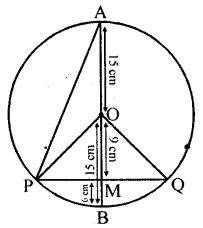
∴ MB = OB – OM = 15 – 9 = 6 cm
AM = OA + OM = 15 + 9 cm = 24 cm
In ∆OMP, by using Pythagoras Theoream,
OP2 = OM2 + PM2
152 = 92 + PM2
= PM2 = 225 – 81
PM = \( \sqrt144 \) = 12 cm
Also, In ∆OMQ,
by using Pythagoras Theorem,
OQ2 = OM2 + QM2
152 = OM2 + QM2
152 = 92 + QM2
QM2 = 225 – 81
QM = \( \sqrt144 \) = 12 cm
∴ PQ = PM + QM (As radius is bisected at M)
⇒ PQ = 12 + 12 cm = 24 cm
(ii) Now in ∆APM
AP2 = AM2 + OM2
AP2 = 242 + 122
AP2 = 576 + 144
AP = \( \sqrt720 \) = 12\( \sqrt5 \) cm
(iii) Now in ∆BMP
BP2 = BM2 + PM2
BP2 = 62 + 122
BP2 = 36 + 144
BP = \( \sqrt180 \) = 6\( \sqrt5 \) cm
Question 2.
The radii of two concentric circles are 17 cm and 10 cm ; a line PQRS cuts the larger circle at P and S and the smaller circle at Q and R. If QR = 12 cm, calculate PQ.
Solution:
A line PQRS intersects the outer circle at P and S and inner circle at Q and R. Radius of outer circle OP = 17 cm and radius of inner circle OQ = 10 cm.
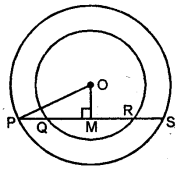
QR = 12 cm
From O, draw OM ⊥ PS
∴ QM = \(\frac{1}{2}\)QR = \(\frac{1}{2}\) × 12 = 6cm
In right ∆OQM,
OQ2 = OM2 + QMv
⇒ (10)2 = OM2 + (6)2
⇒ OM2 = 102 – 62
= 100 – 36 = 64 = (8)2
OM = 8 cm
Now in right ∆OPM,
OP2 = OM2 + PM2
⇒ (17)2 = (8)2 + PM2
⇒ PM2 = (17)2 – (8)2
= 289 – 64 = 225 = (15)2
PM = 15 cm
PQ = PM – QM = 15 – 6 = 9 cm
Question 3.
A chord of length 48 cm is at a distance of 10 cm from the centre of a circle. If another chord of length 20 cm is drawn in the same circle, find its distance from the centre of the circle.
Solution:
O is the centre of the circle
Length of chord AB = 48 cm
and chord CD = 20 cm

OL ⊥ AB and OM ⊥ CD are drawn
AL = LB = \(\frac{48}{2}\) = 24 cm
and CM = MD = \(\frac{20}{2}\) = 10 cm
OL = 10 cm
Now in right ∆AOL
OA2 = AL2 + OL2 (Pythagoras Theorem)
⇒ OA2 = (24)2 + (10)2 = 576 + 100
= 676 = (26)2
∴ OA = 26 cm
But OC = OA (radii of the same circle)
∴ OC = 26 cm
Now in right ∆OCM
OC2 = OM2 + CM2
(26)2 = OM2 + (10)2
676 = OM2 + 100 ⇒ OM2 = 676 – 100
⇒ OM2 = 576 = (24)2
∴ OM = 24 cm
Question 4.
(a) In the figure (i) given below, two circles with centres C, D intersect in points P, Q. If length of common chord is 6 cm and CP = 5 cm, DP = 4 cm, calculate the distance CD correct to two decimal places.
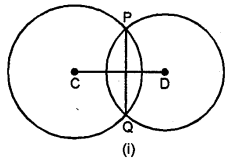
(b) In the figure (ii) given below, P is a point of intersection of two circles with centres C and D. If the st. line APB is parallel to CD, Prove that AB = 2 CD.
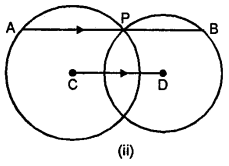
Solution:
(a) Two circles with centre C and D intersect each other at P and Q. PQ is the common chord = 6 cm. The line joining the centres C and D bisects the chord PQ at M.
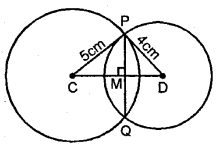
∴ PM = MQ = \(\frac{6}{2}\) = 3 cm
Now in right ∆CPM,
CP2 = CM2 + PM2
⇒ (5)2 = CM2 + (3)2 ⇒ 25 = CM2 + 9
⇒ CM2 = 25 – 9 = 16 = (4)2
∴ CM = 4 cm
and in right ∆PDM,
PD2 = PM2 + MD2
⇒ (4)2 = (3)2 + MD2 ⇒ 16 = 9 + MD2
⇒ MD2 = 16 – 9 = 7
∴ MD = \( \sqrt7 \) = 2·65 cm
∴ CD = CM + MD = 4 + 2·65
= 6·65 cm
(b) Given : Two circles with centre C and D intersect each other at P and Q. A straight line APB is drawn parallel to CD.
To Prove : AB = 2 CD.
Construction : Draw CM and DN perpendicular to AB from C and D.
Proof: ∵ CM ⊥AP
∴ AM = MP or AP = 2 MP
and DN ⊥ PB

∴ BN = PN or PB = 2 PN
Adding
AP + PB = 2 MP + 2 PN
⇒ AB = 2 (MP + PN) = 2 MN
⇒ AB = 2 CD. Q.E.D.
Question 5.
(a) In the figure (i) given below, C and D are centres of two intersecting circles. The line APQB is perpendicular to the line of centres CD. Prove that:
(i) AP = QB
(ii) AQ = BP.
(b) In the figure (ii) given below, two equal chords AB and CD of a circle with centre O intersect at right angles at P. If M and N are mid-points of the chords AB and CD respectively, Prove that NOMP is a square.
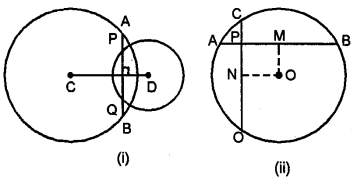
Solution:
(a) Given : Two circles with centres C and D intersect each other. A line APQB is drawn perpendicular to CD at M.
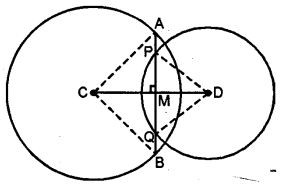
To Prove : (i) AP = QB (ii) AQ = BP.
Construction : Join AC and BC, DP and DQ.
Proof: (i) In right ∆ACM and ∆BCM
Hyp. AC = BC (radii of same circle)
Side CM = CM (common)
∴ ∆ACM ≅ ∆BCM (R.H.S. axiom of congruency)
∴ AM = BM …(i)
Again in right ∆PDM and ∆QDM
Hyp. PD = QD (radii of the same circle)
Side DM = DM (common)
∴ ∆PDM = ∆QDM (R.H.S. axiom of congruency)
∴ PM = QM …(ii)
Subtracting (ii) from (i),
AM – PM = BM – QM ⇒ AP = QB
(ii) Adding PQ both sides,
AP + PQ = PQ + QB
⇒ AQ = PB Q.E.D.
(b) Given : Two chords AB and CD intersect each other at P at right angle in the circle. M and N are mid-points of the chord AB and CD.

To Prove : NOMP is a square.
Proof: ∵ M and N are the mid-points of AB and CD respectively.
∴ OM ⊥ AB and ON ⊥ CD
and OM = ON (∵ Equal chords are at equal distance from the centre)
∵ AB ⊥ CD
∴ OM ⊥ ON
Hence NOMP is a square.
Question 6.
In the given figure, AD is diameter of a circle. If the chord AB and AC are equidistant from its centre O, prove that AD bisects ∠BAC and ∠BDC.
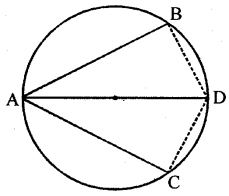
Solution:
Given : AB and AC are equidistant from its centre O
So, AB = AC
In ∆ABD and ∆ACD
AB = AC (given)
∠B = ∠C (∵ Angle in a semicircle is 90°)
AD = AD (common)
∴ ∆ABD ≅ ∆ACD (SSS rule of congruency)
∴ AD bisects ∠BAC and ∠BDC
